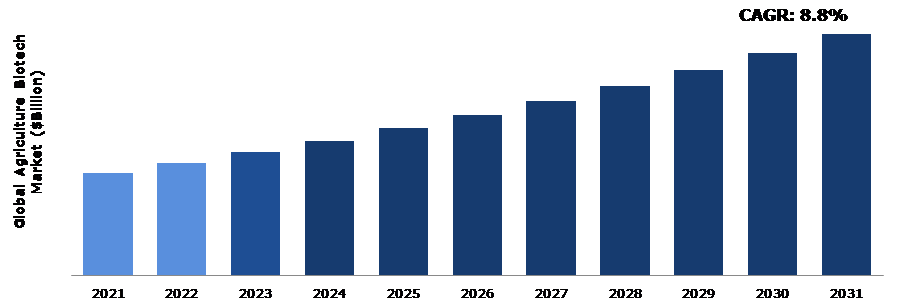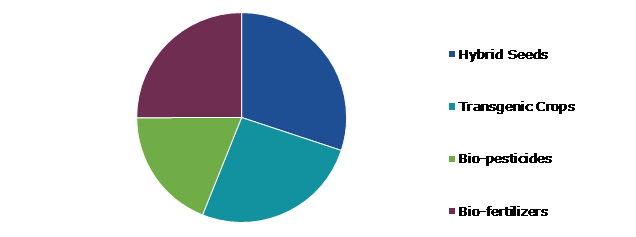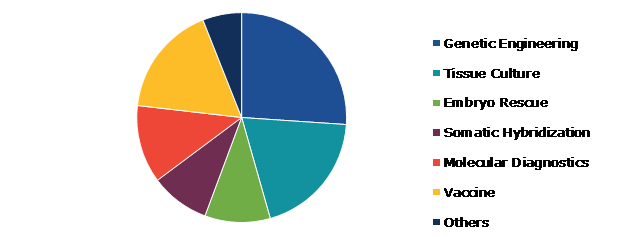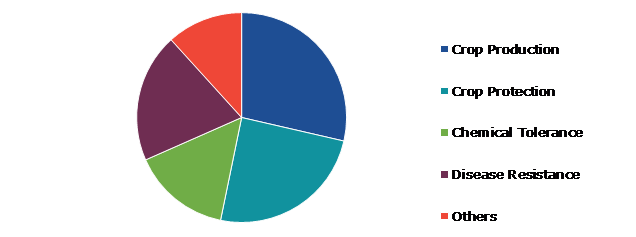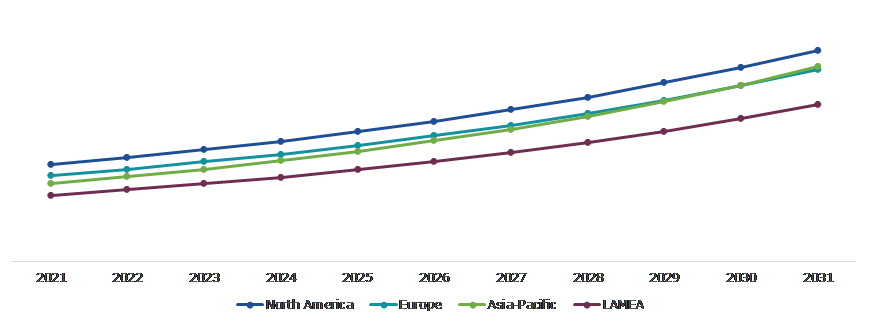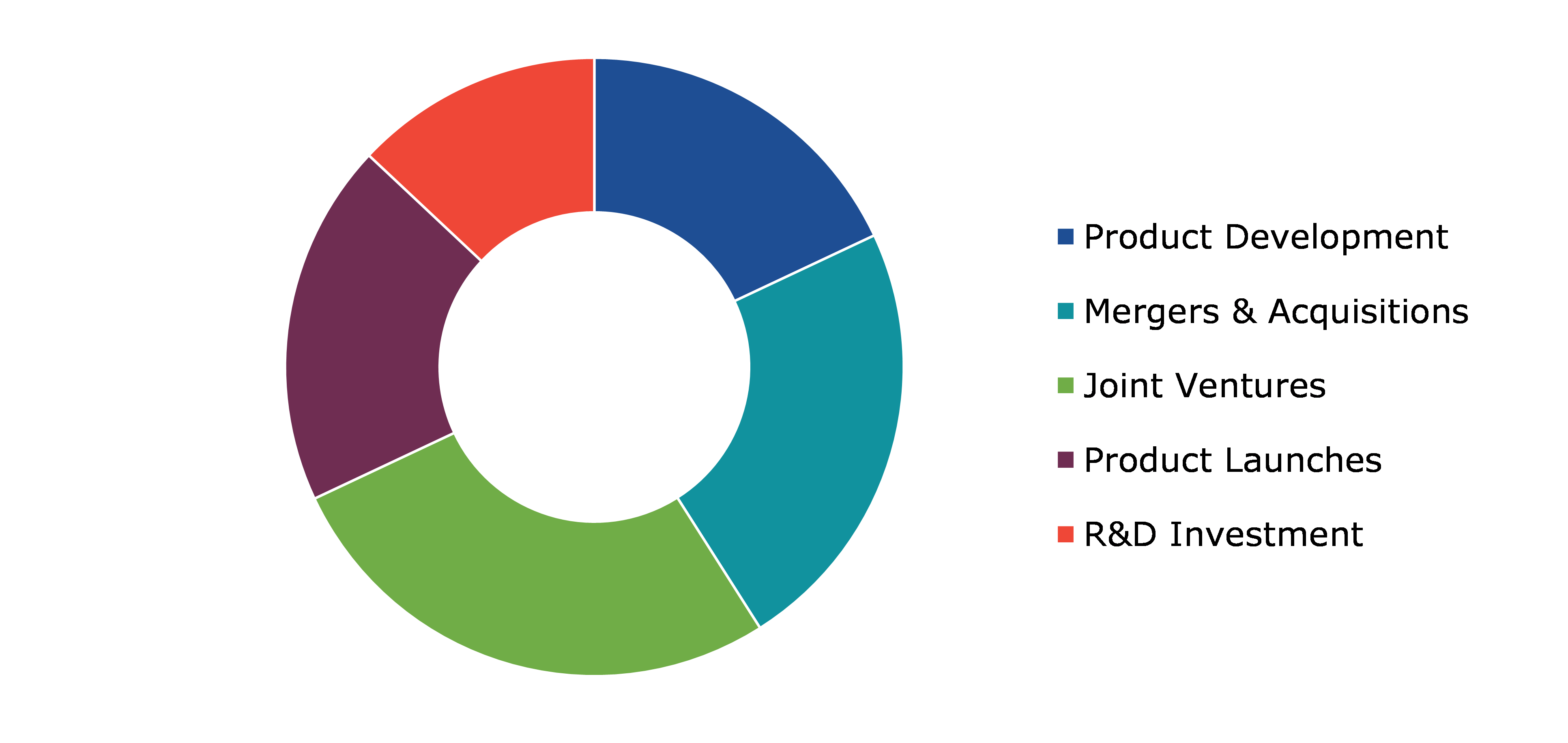Agriculture Biotech Market Report
RA08611
Agriculture Biotech Market by Type (Hybrid Seeds, Transgenic Crops, Bio-pesticides, and Bio-fertilizers), Technology (Genetic Engineering, Tissue Culture, Embryo Rescue, Somatic Hybridization, Molecular Diagnostics, Vaccine, and Others), by Application (Crop Production, Crop Protection, Chemical Tolerance, Disease Resistance, and Others) and Regional Analysis (North America, Europe, Asia-Pacific, and LAMEA): Global Opportunity Analysis and Industry Forecast, 2022-2031
Global Agriculture Biotech Market Analysis
The Global Agriculture Biotech Market Size was $93.1 billion in 2021, and it is predicted to grow with a CAGR of 8.8% by generating a revenue of $214.6 billion by 2031.
Global Agriculture Biotech Market Synopsis
Biotechnology is the use of scientific methods to change and enhance microbes, plants, and animals to increase their value. The branch of biotechnology that involves applications in agriculture is known as agricultural biotechnology. Agricultural biotechnology has been used for a very long time as a means of improving agriculturally significant organisms through breeding and selection. For instance, biotechnology has been used to breed animals with characteristics like quick growth and higher disease resistance. To boost milk output in dairy cows, the growth hormone gene in cattle has been cloned. The surge in the uses of biotechnology in transgenic crops is expected to boost the agriculture biotech market growth during the forecast period. Genetic modification of crops is helping plant breeders to improve plants to minimize important issues of modern agriculture. These transgenic crops show excellent resistance to insects, pathogens, and herbicides.
Lack of research focus and infrastructure in developing economies is anticipated to hamper agriculture biotech market share during the forecast period. Many developing countries lack the understanding of specific areas of agriculture biotech in which investment should be made to meet certain objectives. In addition, the lack of biotech infrastructure in developing nations is challenging for policymakers to make long-term policies.
Agriculture biotech has great potential to improve crop productivity by providing excellent disease resistance and increased drought tolerance to the crops. In addition, agriculture biotech aids in improving the flavor, nutritional value, and texture of foods. For instance, genetically modified soybeans offer higher protein content, and potatoes with more nutritionally available starch and enhanced amino acid content. Such factors are anticipated to boost the agriculture biotech market share during the forecast period.
According to regional analysis, the North America agriculture biotech market size dominated the global market in 2021 on account of well-established biotechnology infrastructure, robust research & development (R&D) funding, increasing population, the burgeoning demand for food, and the rising adoption of cutting-edge technologies for crop cultivation.
Agriculture Biotech Overview
The term "agricultural biotechnology" designates a group of scientific techniques for enhancing plants, animals, and microorganisms. Based on their knowledge of DNA, scientists have developed methods for increasing agricultural yield. Agriculture biotech has the great potential to play a large role in rapidly increasing food demand in developing nations while safeguarding the environment for coming generations. The techniques and products of agricultural biotechnology are generally patentable.
COVID-19 Impact on Global Agriculture Biotech Market
The COVID-19 pandemic has brought several uncertainties leading to severe economic losses as various businesses across the world came to a standstill. Like all businesses, the agricultural biotechnology market also impacted by the COVID-19 pandemic. COVID-19 severely threatened food security around the world. Before the pandemic, already billions of people were suffering from malnutrition and hunger, hence, prompt action is needed to tackle the global food emergency. Dealing with food security is one of the important steps toward post-COVID-19 recovery strategies. In addition, the pandemic disrupted domestic food supply chains in many countries. In the upcoming years, the aftereffects of COVID-19 coupled with the global economic downturn could disrupt the smooth functioning of food systems. Hence, mitigation of such disruption using advanced technologies such as biotechnology is anticipated to augment in the upcoming years. Biotechnology has great potential to help in solving the food security issue. Extensive biotechnology R&D activities in the agriculture sector delivered substantial products on the market and are expected to play important role in facilitating and improving food production substantially.
Growing Need for Biotech Corporations to Improve Nutritional Value Will Drive The Global Agricultural Biotechnology Market Growth
The nutritional value of crops can be increased by using genetic manipulation to create crops with higher vitamin content. With the help of three genes inserted into genetically altered "golden rice," plants are now able to produce beta-carotene, a substance that the human body uses to create vitamin A. Vitamin A deficiency, the leading contributor to blindness worldwide, affects over 250 billion children. To increase the amount of oil produced or to vary the types of oils produced, biotechnology has been used to modify the composition of certain oil crops. Furthermore, growing populations are driving up food product demand, and the ensuing need for food with better nutrition is anticipated to drive up the use of biotechnology in agriculture throughout the projected period.
To know more about global agriculture biotech market drivers, get in touch with our analysts here.
Growing Effects on Human Health Over Agricultural Biotechnology to Restrain the Market Growth
Agricultural biotechnology has just recently been put into use. It is therefore challenging to predict its possible consequences on the environment and health. Since specialists are unaware of the impact of genetically modified goods on human health, there are a variety of perspectives on this topic. Antibiotic resistance genes are used as markers in genetic engineering. These genes might decrease the efficiency of antibiotics, which would be harmful if they were inserted into a plant's genome. Pathogens may potentially acquire the resistance gene, which would make them more resistant to drugs. These risks and uncertainties of agriculture biotechnology are anticipated to hamper the agriculture biotech market growth.
Use of Agriculture Biotech for Marker-assisted Breeding to Drive Excellent Opportunities
Over thousands of years, we have controlled animal and plant development for agricultural interests. Creating a new crop variety, however, requires a lengthy and imprecise procedure called selective breeding. Novel molecular approaches have lately given the selective breeding tank a boost by adding jet fuel. One illustration of this is marker-assisted selection (MAS), in which plant breeding operations are guided, supported, and accelerated by the use of DNA markers. In addition to accelerating plant breeding, MAS provides a great deal more precision than traditional approaches since it relies on genome sequencing and sophisticated bioinformatics techniques to find markers. All these aspects are predicted to boost the agriculture biotech market size in the upcoming years.
To know more about global agriculture biotech market opportunities, get in touch with our analysts here.
Global Agriculture Biotech Market, by Type
Based on type, the market has been divided into hybrid seeds, transgenic crops, bio-pesticides, and bio-fertilizers. Among these, the bio-fertilizers sub-segment is estimated to show the fastest growth during the forecast period.
Global Agriculture Biotech Market Size, by Type, 2021
Source: Research Dive Analysis
The bio-fertilizers sub-type is anticipated to show the fastest growth during the forecast period. As seeds or plants are planted in the soil, bio-fertilizers, which can be living or dormant cells of efficient microorganism strains, interact with the roots of the plants to help them develop. Biofertilizers in the agriculture sector play a significant role, especially in the context of the increased cost of chemical fertilizers and their dangerous impacts on soil quality.
Global Agriculture Biotech Market, by Technology
Based on technology, the market has been divided into genetic engineering, tissue culture, embryo rescue, somatic hybridization, molecular diagnostics, vaccine, and others. Among these, the genetic engineering sub-segment accounted for the highest revenue share in 2021.
Global Agriculture Biotech Market Share, by Technology, 2021
Source: Research Dive Analysis
The genetic engineering sub-segment dominated the market share in 2021. By enhancing the medicinal and nutritional value of crops, genetic engineering helps to increase agricultural productivity. It helps scientists create plants that can endure harmful illnesses and adverse weather. Crop improvement, herbicide resistance, insect resistance, virus resistance, and delayed fruit ripening are just a few of the ways we may apply genetic engineering in agriculture. These factors are anticipated to boost the growth of genetic engineering sub-segment during the analysis timeframe.
Global Agriculture Biotech Market, by Application
based on application, the market has been divided into crop production, crop protection, chemical tolerance, disease resistance, and others. among these, the crop production sub-segment accounted for the highest revenue share in 2021.
Global Agriculture Biotech Market Trends, by Application, 2021
Source: Research Dive Analysis
The crop production sub-segment dominated the market share in 2021. Biotechnology approaches provide practical, affordable answers to pest control issues. Farmers have developed a protein that efficiently combats insect problems from crops including cotton, corn, and potato. Biotechnology significantly increases agricultural output by improving disease control and enhancing resistance to drought and flooding. This not only satisfies the rising food demand but also lowers losses for farmers. These factors are anticipated to boost the growth of the genetic engineering sub-segment during the analysis timeframe.
Global Agriculture Biotech Market, Regional Insights
The agriculture biotech market was investigated across North America, Europe, Asia-Pacific, and LAMEA.
Global Agriculture Biotech Market Size & Forecast by Region, 2021-2031 (USD Billion)
Source: Research Dive Analysis
The Market for Agriculture Biotech in North America is the Most Dominant
the North America region is anticipated to dominate the global agriculture biotech market during the forecast period owing to surging research & development activities, strong government support, rising population, and well-established research infrastructure in this region. Together, the United States and Canada make up around 50% of the world's GM land in this area and about 10% of the world's planted land. Alfalfa, cotton, canola, and barley make up the top five major crops grown in almost 70% of North America's farmed land. Furthermore, with almost 30% of the world's maize, soybean, and wheat output, North America is a net exporter of agricultural goods. During the forecast period, the market expansion is predicted in the area. The agricultural biotechnology industry in North America is being driven by an increase in demand for agri-biotechnology in a variety of applications, including transgenic biotech crops (corn, soybean, and cotton), goods, and tools enabled by synthetic biology. In 2021, the U.S. accounted for a large portion of the North American market for agricultural biotechnology.
Competitive Scenario in the Global Agriculture Biotech Market
Investment and agreement are common strategies followed by major market players. For instance, on May 11, 2022, Lavie Bio Ltd., an Evogene Ltd. subsidiary focused on enhancing food quality, sustainability, and agricultural productivity through the introduction of microbiome-based products, announced that for the 2022 growing season currently underway, Lavie Bio successfully produced and completely sold its planned production quota to U.S. customers.
Source: Research Dive Analysis
Some of the leading agriculture biotech market players are KWS SAAT SE & Co. KGaA, ChemChina, Bayer AG, Corteva, Nufarm, Limagrain, MITSUI & CO., LTD, Evogene Ltd., Valent BioSciences LLC., and Marrone Bio Innovations.
| Aspect | Particulars |
| Historical Market Estimations | 2020 |
| Base Year for Market Estimation | 2021 |
| Forecast Timeline for Market Projection | 2022-2031 |
| Geographical Scope | North America, Europe, Asia-Pacific, LAMEA |
| Segmentation by Type
|
|
| Segmentation by Technology
|
|
|
Segmentation by Application
|
|
| Key Companies Profiled |
|
Q1. What is the size of the global agriculture biotech market?
A. The size of the global agriculture biotech market was over $93.1 billion in 2021 and is projected to reach $214.6 billion by 2031.
Q2. Which are the major companies in the agriculture biotech market?
A. KWS SAAT SE & Co. KGaA, ChemChina, and Bayer AG are some of the key players in the global agriculture biotech market.
Q3. Which region, among others, possesses greater investment opportunities in the near future?
A. The Asia-Pacific region possesses great investment opportunities for investors to witness the most promising growth in the future.
Q4. What will be the growth rate of the Asia-Pacific agriculture biotech market?
A. Asia-Pacific agriculture biotech market is anticipated to grow at 9.7% CAGR during the forecast period.
Q5. What are the strategies opted by the leading players in this market?
A. Agreement and investment are the two key strategies opted for by the operating companies in this market.
Q6. Which companies are investing more in R&D practices?
A. Nufarm, Limagrain, and MITSUI & CO., LTD Company, Inc. are the companies investing more in R&D activities for developing new products and technologies.
1.Research Methodology
1.1.Desk Research
1.2.Real time insights and validation
1.3.Forecast model
1.4.Assumptions and forecast parameters
1.5.Market size estimation
1.5.1.Top-down approach
1.5.2.Bottom-up approach
2.Report Scope
2.1.Market definition
2.2.Key objectives of the study
2.3.Report overview
2.4.Market segmentation
2.5.Overview of the impact of COVID-19 on Global agriculture biotech market
3.Executive Summary
4.Market Overview
4.1.Introduction
4.2.Growth impact forces
4.2.1.Drivers
4.2.2.Restraints
4.2.3.Opportunities
4.3.Market value chain analysis
4.3.1.List of raw material suppliers
4.3.2.List of manufacturers
4.3.3.List of distributors
4.4.Innovation & sustainability matrices
4.4.1.Technology matrix
4.4.2.Regulatory matrix
4.5.Porter’s five forces analysis
4.5.1.Bargaining power of suppliers
4.5.2.Bargaining power of consumers
4.5.3.Threat of substitutes
4.5.4.Threat of new entrants
4.5.5.Competitive rivalry intensity
4.6.PESTLE analysis
4.6.1.Political
4.6.2.Economical
4.6.3.Social
4.6.4.Technological
4.6.5.Environmental
4.7.Impact of COVID-19 on agriculture biotech market
4.7.1.Pre-covid market scenario
4.7.2.Post-covid market scenario
5.Agriculture Biotech Market Analysis, by Type
5.1.Overview
5.2.Hybrid Seeds
5.2.1.Definition, key trends, growth factors, and opportunities
5.2.2.Market size analysis, by region, 2021-2031
5.2.3.Market share analysis, by country, 2021-2031
5.3.Transgenic Crops
5.3.1.Definition, key trends, growth factors, and opportunities
5.3.2.Market size analysis, by region, 2021-2031
5.3.3.Market share analysis, by country, 2021-2031
5.4.Bio-pesticides
5.4.1.Definition, key trends, growth factors, and opportunities
5.4.2.Market size analysis, by region, 2021-2031
5.4.3.Market share analysis, by country, 2021-2031
5.5.Bio-fertilizers
5.5.1.Definition, key trends, growth factors, and opportunities
5.5.2.Market size analysis, by region, 2021-2031
5.5.3.Market share analysis, by country, 2021-2031
5.6.Research Dive Exclusive Insights
5.6.1.Market attractiveness
5.6.2.Competition heatmap
6.Agriculture Biotech Market Analysis, by Technology
6.1.Genetic Engineering
6.1.1.Definition, key trends, growth factors, and opportunities
6.1.2.Market size analysis, by region, 2021-2031
6.1.3.Market share analysis, by country, 2021-2031
6.2.Tissue Culture
6.2.1.Definition, key trends, growth factors, and opportunities
6.2.2.Market size analysis, by region, 2021-2031
6.2.3.Market share analysis, by country, 2021-2031
6.3.Embryo Rescue
6.3.1.Definition, key trends, growth factors, and opportunities
6.3.2.Market size analysis, by region, 2021-2031
6.3.3.Market share analysis, by country, 2021-2031
6.4.Somatic Hybridization
6.4.1.Definition, key trends, growth factors, and opportunities
6.4.2.Market size analysis, by region, 2021-2031
6.4.3.Market share analysis, by country, 2021-2031
6.5.Molecular Diagnostics
6.5.1.Definition, key trends, growth factors, and opportunities
6.5.2.Market size analysis, by region, 2021-2031
6.5.3.Market share analysis, by country, 2021-2031
6.6.Vaccine
6.6.1.Definition, key trends, growth factors, and opportunities
6.6.2.Market size analysis, by region, 2021-2031
6.6.3.Market share analysis, by country, 2021-2031
6.7.Others
6.7.1.Definition, key trends, growth factors, and opportunities
6.7.2.Market size analysis, by region, 2021-2031
6.7.3.Market share analysis, by country, 2021-2031
6.8.Research Dive Exclusive Insights
6.8.1.Market attractiveness
6.8.2.Competition heatmap
7.Agriculture Biotech Market Analysis, by Application
7.1.Crop Production
7.1.1.Definition, key trends, growth factors, and opportunities
7.1.2.Market size analysis, by region, 2021-2031
7.1.3.Market share analysis, by country, 2021-2031
7.2.Crop Protection
7.2.1.Definition, key trends, growth factors, and opportunities
7.2.2.Market size analysis, by region, 2021-2031
7.2.3.Market share analysis, by country, 2021-2031
7.3.Chemical Tolerance
7.3.1.Definition, key trends, growth factors, and opportunities
7.3.2.Market size analysis, by region, 2021-2031
7.3.3.Market share analysis, by country, 2021-2031
7.4.Disease Resistance
7.4.1.Definition, key trends, growth factors, and opportunities
7.4.2.Market size analysis, by region, 2021-2031
7.4.3.Market share analysis, by country, 2021-2031
7.5.Others
7.5.1.Definition, key trends, growth factors, and opportunities
7.5.2.Market size analysis, by region, 2021-2031
7.5.3.Market share analysis, by country, 2021-2031
7.6.Research Dive Exclusive Insights
7.6.1.Market attractiveness
7.6.2.Competition heatmap
8.Agriculture Biotech Market, by Region
8.1.North America
8.1.1.U.S.
8.1.1.1.Market size analysis, by Type, 2021-2031
8.1.1.2.Market size analysis, by Technology, 2021-2031
8.1.1.3.Market size analysis, by Application, 2021-2031
8.1.2.Canada
8.1.2.1.Market size analysis, by Type, 2021-2031
8.1.2.2.Market size analysis, by Technology, 2021-2031
8.1.2.3.Market size analysis, by Application, 2021-2031
8.1.3.Research Dive Exclusive Insights
8.1.3.1.Market attractiveness
8.1.3.2.Competition heatmap
8.2.Europe
8.2.1.Germany
8.2.1.1.Market size analysis, by Type, 2021-2031
8.2.1.2.Market size analysis, by Technology, 2021-2031
8.2.1.3.Market size analysis, by Application, 2021-2031
8.2.2.UK
8.2.2.1.Market size analysis, by Type, 2021-2031
8.2.2.2.Market size analysis, by Technology, 2021-2031
8.2.2.3.Market size analysis, by Application, 2021-2031
8.2.3.France
8.2.3.1.Market size analysis, by Type, 2021-2031
8.2.3.2.Market size analysis, by Technology, 2021-2031
8.2.3.3.Market size analysis, by Application, 2021-2031
8.2.4.Spain
8.2.4.1.Market size analysis, by Type, 2021-2031
8.2.4.2.Market size analysis, by Technology, 2021-2031
8.2.4.3.Market size analysis, by Application, 2021-2031
8.2.5.Italy
8.2.5.1.Market size analysis, by Type, 2021-2031
8.2.5.2.Market size analysis, by Technology, 2021-2031
8.2.5.3.Market size analysis, by Application, 2021-2031
8.2.6.Rest of Europe
8.2.6.1.Market size analysis, by Type, 2021-2031
8.2.6.2.Market size analysis, by Technology, 2021-2031
8.2.6.3.Market size analysis, by Application, 2021-2031
8.2.7.Research Dive Exclusive Insights
8.2.7.1.Market attractiveness
8.2.7.2.Competition heatmap
8.3.Asia Pacific
8.3.1.China
8.3.1.1.Market size analysis, by Type, 2021-2031
8.3.1.2.Market size analysis, by Technology, 2021-2031
8.3.1.3.Market size analysis, by Application, 2021-2031
8.3.2.Japan
8.3.2.1.Market size analysis, by Type, 2021-2031
8.3.2.2.Market size analysis, by Technology, 2021-2031
8.3.2.3.Market size analysis, by Application, 2021-2031
8.3.3.India
8.3.3.1.Market size analysis, by Type, 2021-2031
8.3.3.2.Market size analysis, by Technology, 2021-2031
8.3.3.3.Market size analysis, by Application, 2021-2031
8.3.4.Australia
8.3.4.1.Market size analysis, by Type, 2021-2031
8.3.4.2.Market size analysis, by Technology, 2021-2031
8.3.4.3.Market size analysis, by Application, 2021-2031
8.3.5.South Korea
8.3.5.1.Market size analysis, by Type, 2021-2031
8.3.5.2.Market size analysis, by Technology, 2021-2031
8.3.5.3.Market size analysis, by Application, 2021-2031
8.3.6.Rest of Asia Pacific
8.3.6.1.Market size analysis, by Type, 2021-2031
8.3.6.2.Market size analysis, by Technology, 2021-2031
8.3.6.3.Market size analysis, by Application, 2021-2031
8.3.7.Research Dive Exclusive Insights
8.3.7.1.Market attractiveness
8.3.7.2.Competition heatmap
8.4.LAMEA
8.4.1.Brazil
8.4.1.1.Market size analysis, by Type, 2021-2031
8.4.1.2.Market size analysis, by Technology, 2021-2031
8.4.1.3.Market size analysis, by Application, 2021-2031
8.4.2.Saudi Arabia
8.4.2.1.Market size analysis, by Type, 2021-2031
8.4.2.2.Market size analysis, by Technology, 2021-2031
8.4.2.3.Market size analysis, by Application, 2021-2031
8.4.3.UAE
8.4.3.1.Market size analysis, by Type, 2021-2031
8.4.3.2.Market size analysis, by Technology, 2021-2031
8.4.3.3.Market size analysis, by Application, 2021-2031
8.4.4.South Africa
8.4.4.1.Market size analysis, by Type, 2021-2031
8.4.4.2.Market size analysis, by Technology, 2021-2031
8.4.4.3.Market size analysis, by Application, 2021-2031
8.4.5.Rest of LAMEA
8.4.5.1.Market size analysis, by Type, 2021-2031
8.4.5.2.Market size analysis, by Technology, 2021-2031
8.4.5.3.Market size analysis, by Application, 2021-2031
8.4.6.Research Dive Exclusive Insights
8.4.6.1.Market attractiveness
8.4.6.2.Competition heatmap
9.Competitive Landscape
9.1.Top winning strategies, 2021
9.1.1.By strategy
9.1.2.By year
9.2.Strategic overview
9.3.Market share analysis, 2021
10.Company Profiles
10.1.KWS SAAT SE & Co. KGaA
10.1.1.Overview
10.1.2.Business segments
10.1.3.Product portfolio
10.1.4.Financial performance
10.1.5.Recent developments
10.1.6.SWOT analysis
10.2.ChemChina
10.2.1.Overview
10.2.2.Business segments
10.2.3.Product portfolio
10.2.4.Financial performance
10.2.5.Recent developments
10.2.6.SWOT analysis
10.3.Bayer AG.
10.3.1.Overview
10.3.2.Business segments
10.3.3.Product portfolio
10.3.4.Financial performance
10.3.5.Recent developments
10.3.6.SWOT analysis
10.4.Corteva
10.4.1.Overview
10.4.2.Business segments
10.4.3.Product portfolio
10.4.4.Financial performance
10.4.5.Recent developments
10.4.6.SWOT analysis
10.5.Nufarm
10.5.1.Overview
10.5.2.Business segments
10.5.3.Product portfolio
10.5.4.Financial performance
10.5.5.Recent developments
10.5.6.SWOT analysis
10.6.Limagrain
10.6.1.Overview
10.6.2.Business segments
10.6.3.Product portfolio
10.6.4.Financial performance
10.6.5.Recent developments
10.6.6.SWOT analysis
10.7.MITSUI & CO., LTD
10.7.1.Overview
10.7.2.Business segments
10.7.3.Product portfolio
10.7.4.Financial performance
10.7.5.Recent developments
10.7.6.SWOT analysis
10.8.Evogene Ltd.
10.8.1.Overview
10.8.2.Business segments
10.8.3.Product portfolio
10.8.4.Financial performance
10.8.5.Recent developments
10.8.6.SWOT analysis
10.9.Valent BioSciences LLC
10.9.1.Overview
10.9.2.Business segments
10.9.3.Product portfolio
10.9.4.Financial performance
10.9.5.Recent developments
10.9.6.SWOT analysis
10.10.Marrone Bio Innovations
10.10.1.Overview
10.10.2.Business segments
10.10.3.Product portfolio
10.10.4.Financial performance
10.10.5.Recent developments
10.10.6.SWOT analysis
Agriculture biotech generally refers to use of biotechnology and similar techniques in agriculture and allied activities like animal husbandry in order to enhance the productivity. In particular, agriculture biotech uses tools of genetic engineering to modify agricultural products, such as use of biotechnology to boost the production of milk or to enhance crop yield. Agriculture biotech, in case of crops, also helps in developing improved variety of crops which are drought-resistant, disease and pest resistant, etc. Along with this, agriculture biotech can also be used to enhance the nutritional content of the foodgrains.
Forecast Analysis of the Global Market
In the recent years, there has been an increase in the use of biotechnology tools and techniques in agriculture for marker-assisted breeding. This growth in use of agriculture biotech is expected to be the primary growth driver of the agriculture biotech market in the forecast years. Along with this, surge in the use of biotechnology in transgenic crops is expected to push the market further. Also, growing need for biotech corporations to improve nutritional value is predicted to offer numerous investment and growth opportunities to the market in the analysis timeframe. However, fears of negative impact of genetically modified goods on human health may restrain the growth of the agriculture biotech market in the forecast period.
Regionally, the agriculture biotech market in the North America region is expected to be the most dominant by 2031. Surging research & development activities and strong government support are anticipated to become the two main growth drivers of the market in this region.
According to the report published by Research Dive, the global agriculture biotech market is expected to gather a revenue of $214.6 billion by 2031 and grow at 8.8% CAGR in the 2022-2031 timeframe. Some prominent market players include KWS SAAT SE & Co. KGaA, Nufarm, Evogene Ltd., ChemChina, Limagrain, Valent BioSciences LLC., Bayer AG, MITSUI & CO., LTD, Marrone Bio Innovations, Corteva, and many others.
Covid-19 Impact on the Market
The outbreak of the Covid-19 pandemic has had a massive negative effect on almost all industries and businesses across the world. The agriculture biotech market faced a similar fate due to the pandemic. The primary reason behind the slowdown of the market was disruptions in global food supply chains which resulted in massive food shortages across the globe. Also, the research in biotechnology was mainly focused on vaccines and drug development during these years. This further brought down the growth rate of the market.
Significant Market Developments
The significant companies operating in the industry are adopting numerous growth strategies & business tactics such as partnerships, collaborations, mergers & acquisitions, and launches to maintain a robust position in the overall market, thus helping the agriculture biotech market to flourish. For instance:
- In July 2020, Advanced Biological Marketing (ABM), a commercial agriculture solutions provider, announced the launch of a metabolite derived from Trichoderma. This new product is a first-of-its-kind, non-living biological seed treatment launched by ABM and the product launch is expected to create numerous growth opportunities for the company in the coming period.
- In January 2021, VIB, a leading life sciences institution, announced the acquisition of CropDesign site from BASF, a multinational chemicals company. This acquisition is aimed at launching the first agriculture biotech incubator which will help VIB to expand its footprint in the agriculture biotech market in the near future.
- In January 2022, Symborg, a biotechnology company based in Spain, announced the acquisition of Glen Biotech, an agriculture biotech startup. This acquisition is predicted to help the acquiring company, i.e., Symborg to cater to the demands of the market in a more holistic way and consolidate its position as the leader of the market.
Personalize this research
- Triangulate with your own data
- Request your format and definition
- Get a deeper dive on a specific application, geography, customer or competitor
- + 1-888-961-4454 Toll - Free
- support@researchdive.com

